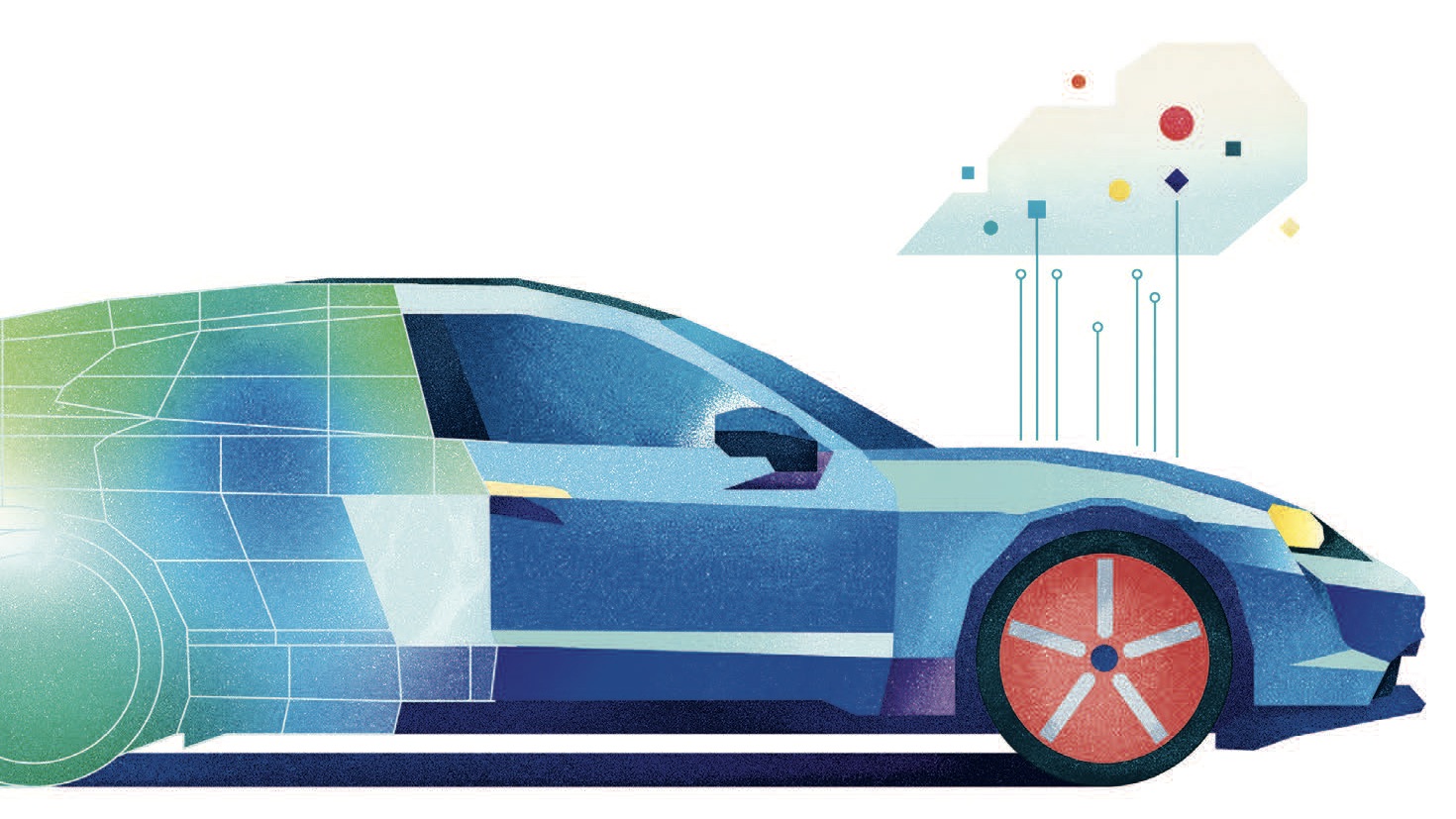In the past, a test drive was over when the vehicle was parked in the garage. Today, it also continues well after this—for example, when testing the road-readiness of battery-electric models, which is also carried out at night and on weekends. This involves the vehicle automatically switching itself to start mode several hundred times: The temperature, voltage and capacity of the high-voltage battery are checked and the onboard systems are prepared to hit the road. Each time it is started, data loggers record all communication in the vehicle—up to three gigabytes of raw data per test, or roughly the equivalent of 40,000 emails without an attachment. The measurement data is then sent to the cloud via a mobile network or WiFi, where it is processed and analyzed. All of this proceeds automatically. “When the engineer arrives at the office in the morning, there is an email in their mailbox that indicates the availability of the data and results of the test,” says Jonas Brandstetter, Development Engineer at Porsche Engineering.
Boost thanks to the cloud
This type of data-driven vehicle development is rapidly gaining in importance. For a growing number of technical issues, extensive data analyses can provide a broader empirical basis and complement the experience of the engineers. Data-driven development is given an additional boost by the cloud, as much more test data can be evaluated with the help of online processing capacity. This accelerates development work and, at the same time, leads to more effective use of IT infrastructure. “The cloud can deliver added value in almost all areas,” says Brandstetter.
Experts estimate that the amount of digital information in the vehicle has increased by a factor of ten in recent years. If modern driver assistance, ADAS and safety systems are added to this, the data volume increases again by a factor of 800 (also see the article on page 10). “What customer and test vehicles will deliver in the future can no longer be processed manually,” says Daniel Schumacher, Specialist for Cloud Architecture at Porsche Engineering.
“In the morning, there is an email in the inbox that indicates the availability of the data and results of the test.” Jonas Brandstetter, Development Engineer at Porsche Engineering
In concrete terms: In its original version, the bus technology CAN (Controller Area Network) was designed for one million bits per second. Its successor, automotive ethernet, can transmit ten thousand times that amount—ten gigabits per second. In other words, as much data flows through the vehicle in 3.5 seconds as is required for a complete feature film on DVD. The data also originates from more and more sources. Porsche Engineering has fully equipped its latest test vehicles with the JUPITER system (Joint User Personalized Integrated Testing and Engineering Resource) with laser scanners that record 1.5 million measuring points every second.
With the help of the ComBox, which can be installed in the vehicle in just a few steps, this and other information can be transferred to the cloud in real time. Another data source is hardware-in-the-loop (HiL) systems, in which parts of the vehicle are simulated, for example the cockpit with the instrument cluster and operating elements. This allows the infotainment system for a new model to be tested before the actual vehicle is available.
In the past, data was usually analyzed on-premises. Development engineers transferred measured values from the test drives to local computers and evaluated them there. The drawbacks of this procedure: A lot of manual work is required; only people in the respective department have access to the data; and a separate IT infrastructure must be set up for each task, the capacity of which might not be optimally utilized later on.
These drawbacks can be eliminated by using the cloud. If data is uploaded to a central data lake, any number of developers can access it— whether they work in Czechia, Romania, China, Italy or Germany. “This is the ideal platform for allowing specialists from all over the world to participate,” says Daniel Meissner, Senior IT Specialist at Porsche Engineering. What’s more, the external computer capacities are adaptable. Entire systems or computing nodes can be added or removed as required depending on the task.
Unified data structure
Preliminary work is, however, required to take advantage of the benefits of the cloud. “We need to make all the data available in a uniform structure,” explains Schumacher. The format in which a measuring instrument or sensor delivers its data depends on the specific manufacturer and the software used internally. There are also several standards for internal vehicle communication (CAN, FlexRay, automotive ethernet). In order to view the data separately from the respective hardware, Porsche Engineering uses a kind of intermediate layer—the Robot Operating System (ROS). This programming framework, which was originally developed for industrial robots, provides a uniform data format and tools for evaluation.
Unlike on-premises work, the evaluation of a test drive can begin today while a vehicle is still on the track anywhere in the world. JUPITER vehicles, for example, are directly connected to the cloud via 5G. This means that the first work step can be carried out while the vehicle is still driving—a step known as pre-processing: The data that was compressed for transport is reverted to its initial state. A selection is then made, as not every piece of digital information is relevant for the development of a driving function. In the road-readiness tests mentioned above, for example, an algorithm selects those tests in which a control unit on the vehicle bus did not react quickly enough— for example, if it did not start up within the required 200 milliseconds but required 400 milliseconds.
“I only see the one or two cases out of 100 where something didn’t proceed optimally,” says Adalbert Rosinski, an expert for networking and bus systems at Porsche AG. In the past, he would have had to carry out this time-consuming pre-selection process himself. Moreover, much more data is available since the tests are carried out automatically and are pre-evaluated. “The number of test cases has increased by a factor of 20 to 30,” Rosinski estimates. This increases the chance of discovering optimization potential.
“What customer and test vehicles will deliver in the future can no longer be processed manually.” Daniel Schumacher, Specialist for Cloud Architecture at Porsche Engineering
Evaluation with Machine Learning
In addition to the data, the analysis tools that the developers have previously worked with locally must also be transferred to the cloud. This is the step usually associated with the greatest amount of work. “We work intensively with the respective department when converting into code,” reports Schumacher.
A typical example of automotive development is a threshold or characteristic curve analysis, in which software examines a time series and marks areas in which the data has reached a critical level. In addition, evaluation using machine learning is becoming more and more widespread: An algorithm is fed large sets of real data and autonomously learns to recognize critical moments. Both analysis methods can be transferred to the cloud without any problems. In order to perform an analysis on multiple computers in parallel, the work must be divided into small packages—experts talk about making it cloud enabled.
An eight-hour test drive, for example, is divided into segments of one hour each. The measurement data is combined with the analysis code to form packages; these containers, as they are called, can then be distributed to virtual machines in the network. “In the cloud, up to 200 processes can be started in parallel,” adds Brandstetter; “in the past, you would have had to have 200 computers available locally for that.”
The developers receive the results of the cloud evaluation in the HyDA format (hybrid data and analysis), this being a mix of measurement data and evaluation. “This enables the engineer to carry out an analysis at every level,” explains Brandstetter. They can, for example, have a complete true/false evaluation displayed for a data series—or, if necessary, take a deep dive into the analysis of 300 individual signals.
“I only see the one or two cases out of 100 where something didn’t proceed optimally.” Adalbert Rosinski, Expert for networking and bus systems at Porsche AG
No alternative in the long run
The advantages of working in the cloud are obvious: More speed, more data and a broader data basis for decision-making processes. Moving to the cloud is challenging, however. “It means a completely new way of working,” as Meissner concedes. To make it easier to get started, the cloud experts at Porsche Engineering work intensively with the specialist departments. “We don’t want to take over the work, but take our colleagues along for the ride,” as Meissner describes the approach.
In small workshops and accompanied by consultants, the specialist departments bring their processes to the cloud themselves. The experts agree on one point: in the long run, there is no alternative to data-driven development. “In the future, it will be a matter of validating software before it even reaches the control unit in the vehicle,” explains networking expert Rosinski. Trials willincreasingly take place in virtual test environments, he continues. At the same time, significantly morevalidation cycles will be run in the same amount of time. Without the new architecture in the cloud, he says, this pace would not be feasible.
Summary
Data-driven development is rapidly gaining importance. The cloud provides an additional boost, as much more test data can be evaluated there in a short time. Porsche Engineering uses data-driven development and is applying the method in more and more technical fields.
“Software is the engine of the future—this is underscored by the close partnership we have entered into with the Volkswagen Group.” Dr. Markus Stinner, Automotive expert at Microsoft Germany
Analyzing Data during the drive – with maximum security
Porsche Engineering uses the Microsoft Azure Cloud as a platform for processing development data. The so-called zero-trust model ensures maximum security for sensitive data. The initial assumption is that all devices are insecure, including those connected via a virtual private network (VPN). “Every access must be authenticated, authorized and encrypted,” explains Dr. Markus Stinner, automotive expert at Microsoft Germany.
A development vehicle is approached as an Internet of Things device with its own security certificates. Data uploads can be individually authenticated and authorized. “Using this architecture, we can also stream development data from the vehicle with a minimum of delay,” says Stinner. The actual analysis takes place in a Kubernetes cluster in the cloud.
A Kubernetes cluster is a group of virtual machines that can perform many tasks in parallel. The prerequisite for this is that the tasks were first made parallelizable—i.e. divided into small packages. This is done using docker containers, which contain everything the virtual machine needs to be able to work: Operating system (parts), program code and data to be processed.
An eight-hour test drive, for example, is divided into segments of one hour each and is then saved together with the respective analysis tool in a container. This means that several hundred hours of test drives can be evaluated in parallel in the cloud. For cloud provider Microsoft, the automotive sector plays an extremely important role. “Software is the engine of the future—this is underscored by the close partnership we have entered into with the Volkswagen Group.” Autonomous driving will increase the complexity of software even further. “We want to tackle this challenge together with Porsche Engineering.”
Info
Text first published in the Porsche Engineering Magazine, issue 2/2023
Text: Constantin Gillies
Illustrations: Dan Matutina
Copyright: All images, videos and audio files published in this article are subject to copyright. Reproduction in whole or in part is not permitted without the written consent of Dr. Ing. h.c. F. Porsche AG. Please contact newsroom@porsche.com for further information.



